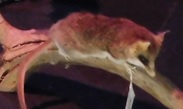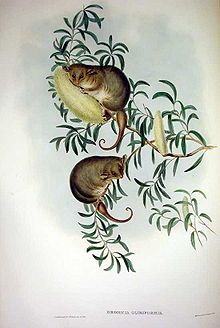
Phalangeriformes is a paraphyletic suborder of about 70 species of small to medium-sized arboreal marsupials native to Australia, New Guinea, and Sulawesi. The species are commonly known as possums, gliders, and cuscus. The common name "possum" for various Phalangeriformes species derives from the creatures' resemblance to the opossums of the Americas. However, although opossums are also marsupials, Australasian possums are more closely related to other Australasian marsupials such as kangaroos.

Diprotodontia is the largest extant order of marsupials, with about 155 species, including the kangaroos, wallabies, possums, koala, wombats, and many others. Extinct diprotodonts include the hippopotamus-sized Diprotodon, and Thylacoleo, the so-called "marsupial lion".

The monito del monte or colocolo opossum, Dromiciops gliroides, also called chumaihuén in Mapudungun, is a diminutive marsupial native only to southwestern South America. It is the only extant species in the ancient order Microbiotheria, and the sole New World representative of the superorder Australidelphia, being more closely related to Australian marsupials than to other American marsupials. The species is nocturnal and arboreal, and lives in thickets of South American mountain bamboo in the Valdivian temperate forests of the southern Andes, aided by its partially prehensile tail. It consumes an omnivorous diet based on insects and fruit.

The Acrobatidae are a small family of gliding marsupials containing two genera, each with a single species, the feathertail glider from Australia and feather-tailed possum from New Guinea.

The mountain pygmy possum ; also simply known as the burramys, is a small, mouse-sized nocturnal marsupial of Australia found in dense alpine rock screes and boulder fields, mainly southern Victoria and around Mount Kosciuszko in Kosciuszko National Park in New South Wales at elevations from 1,300 to 2,230 metres. At almost 14 cm (5.5 in), its prehensile tail is longer than its 11 cm (4.3 in) combined head and body length. Its diet consists of insects, fleshy fruits, nuts, nectar and seeds. Its body is covered in a thick coat of fine grey fur except for its stomach, which is cream coloured; its tail is hairless. On the underside of the female's body is a pouch containing four teats. This possum is the only extant species in the genus Burramys. It is also the only Australian mammal restricted to alpine habitat.

Australidelphia is the superorder that contains roughly three-quarters of all marsupials, including all those native to Australasia and a single species — the monito del monte — from South America. All other American marsupials are members of the Ameridelphia. Analysis of retrotransposon insertion sites in the nuclear DNA of a variety of marsupials has shown that the South American monito del monte's lineage is the most basal of the superorder.

Burramys is a genus of the family Burramyidae, and is represented by one living and 3 extinct (fossil) species. It is one of two genera of pygmy possum, the other being Cercartetus.

The Tasmanian pygmy possum, also known as the little pygmy possum or tiny pygmy possum, is the world's smallest possum. It was first described by Oldfield Thomas in 1888, after he identified that a museum specimen labelled as an eastern pygmy possum in fact represented a species then unknown to science. The holotype resides in the Natural History Museum in London.

Pseudocheiridae is a family of arboreal marsupials containing 17 extant species of ringtailed possums and close relatives. They are found in forested areas and shrublands throughout Australia and New Guinea.

The long-tailed pygmy possum is a diprotodont marsupial found in the rainforests of northern Australia and New Guinea. Living at altitudes of above 1,500 m (4,900 ft), it eats insects and nectar, and may eat pollen in place of insects in the wild.

The eastern pygmy possum is a diprotodont marsupial of south-eastern Australia. Occurring from southern Queensland to eastern South Australia and also Tasmania, it is found in a range of habitats, including rainforest, sclerophyll forest, woodland and heath.

The western pygmy possum, also known as the southwestern pygmy possum or the mundarda, is a small marsupial found in Australia. Genetic studies indicate its closest relative is probably the eastern pygmy possum, from which its ancestors diverged around eight million years ago.

The genus Cercartetus is a group of very small possums known as pygmy possums. Four species comprise this genus, which together with the genus Burramys make up the marsupial family Burramyidae.

Mallomys is a genus of rodent in the family Muridae. The name of the genus is formed from the Greek μαλλός, mallos, wool, and μῦς, mus, mouse/rat. These very large rats weigh between 0.95 and 2 kilograms and are native to highlands in New Guinea. Little is known about their behavior, but they are believed to feed on leaves, grasses and other plant material.
Riversleigh fauna is the collective term for any species of animal identified in fossil sites located in the Riversleigh World Heritage Area.
Heath's tick is a critically endangered invertebrate native to the Australian alps. It has a close symbiotic relationship with the mountain pygmy possum, and is believed to depend on this species for its survival.
















